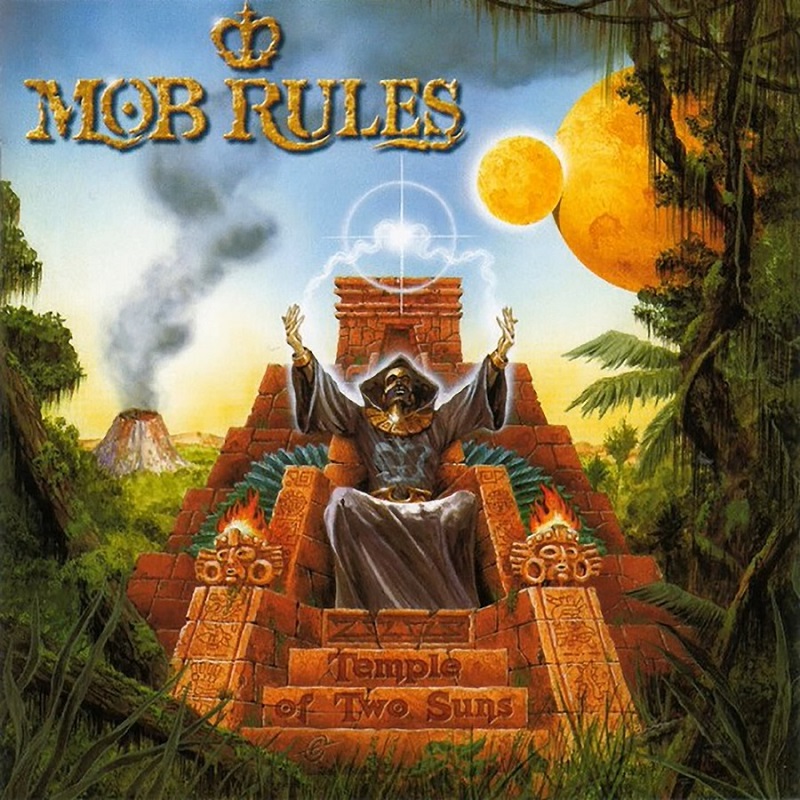Slowly coming together - 78%
The career of Germany’s Mob Rules has largely been characterized by gradual improvement. I’m writing this in 2018, at which point they have become a vehicle for consistent and forceful power metal that occasionally ventures into quasi-progressive or folk dimensions. Their first effort, 1999’s Savage Land, lay something of a foundation for all of these ingredients, but though it undoubtedly had some nice moments, it also fell victim to a lot of inconsistent execution on the songwriting, arrangement, and performance fronts.
The band’s second album, 2000’s Temple of Two Suns, begins to see their sound coalesce a bit more. It’s a more consistent album than Savage Land, and there aren’t any songs that really flop, but the slight majority of its runtime remains filled with workmanlike, decent power metal rather than highlights.
As with the first album, the general rule here is “the simpler, the better.” Mob Rules can pull off the lively three-minute uptempo speeder format well, as the album gets off to quite a strong start with quasi-overture “The Temple Fanfare,” “Pilot of Earth,” and “Outer Space.” Late-album track “Eyes of All Young” also falls below the four-minute mark and coasts along nicely.
It’s when the band tries to mix things up from that quick-hitting template that they lose impact, for many of the same reasons as the debut. Klaus Dirks still sings in the same upper-midrange octave all the time, and guitarists Matthias Mineur and Oliver Fuhlhage continue to stick to extremely basic lead patterns that function more as interludes than solos most of the time. As such, neither the vocals or guitars achieve any sort of contrast, which is fine in a three-minute speeder but less palatable in five-plus-minute midtempo tracks like the ones that make up the bulk of this album. To their credit, the band mostly stopped trying to compensate for this deficiency with arbitrary clean guitar sections and other ill-fitting arrangement shifts, so the songs at least are able to lock into something of a consistent groove.
Further helping things along is that the grasp of melody construction inches forward slightly here, as a number of the choruses have a sort of building character that effectively bridges typical power metal bombast and folk metal storytelling. Even as Dirks stays in the same range with the same somewhat nasal tonality, the moments of melodic catchiness are more frequent here, pulling otherwise unremarkable songs like “Unknown Man” and “Evolution’s Falling” into a higher level of quality.
Speaking of “Unknown Man,” I do want to make note of the bridge of the song, because it’s literally the one time in Dirks’ long career fronting this band (at least that I can recall at the present moment) that he breaks out of the ultra-clean style. All of a sudden, he’s inexplicably a higher-pitched Ronnie James Dio, with a surprisingly gritty timbre that removes the slightly whiny character of most of his higher vocals. It’s my favorite vocal moment of Dirks’ career, and I don’t understand why he never employs that style anywhere else, because it would do wonders to add some dynamic contrast to the sound.
The instrumentalists all deliver fairly restrained performances that range from inoffensive to solid. Perhaps the most striking member of the ensemble actually is session keyboardist Sascha Onnen, who adds some nice leads that veer toward Dio’s “Rainbow in the Dark,” a few folky violin sections that are hit or miss, and some generally strong textural augmentations. Onnen also gets one true keyboard solo on “Eyes of All Young,” and it outdoes all of the guitar soloing in both technicality and impact. Arved Mannott’s drumming is less prominent than on the debut—it’s perhaps the only element that isn’t as strong—but it remains reasonably propulsive and effective. Thorsten Plorin’s bass is active and has some nice grooves.
As for the riff work, it also edges forward and has its strong moments. The riffs are fairly basic in character, both in rhythm and note choice, and so they do frequently have something of a generic quality, but Mineur and Fuhlhage do wring some nice use out of their limited arsenal. A number of these songs have interludes where the basic chugging guitars mesh surprisingly well with Onnen’s string patches, lending the music a stately, grandiose feel that most of the other sections don’t have. There’s also a few moments of more classic metal gallop work that comes off more energetic, especially in the faster tracks. The solos are the weakest element of the band, however. They mostly aim for atmosphere, which is an odd if still interesting choice, but they lack the melodic sophistication to really come up with any sort of impactful result. The one solo that really adds something is the one in “Pilot of Earth,” which opts for more of an ‘80s rock approach that brings more energy.
All told, Temple of Two Suns represented a step forward for Mob Rules, as there aren’t any clunkers to be found, and you can hear the band coming to an increased grasp of their ambitions, achieving strong results with more frequency than on their debut. It makes the album a much more cohesive listen than Savage Land, though it still contains many moments that fail to fully satisfy, exemplifying potential not yet fully realized.

